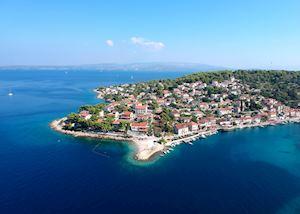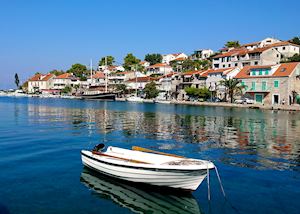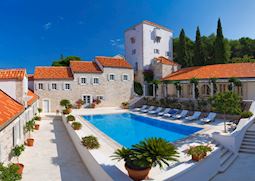Jump to:
With the same combination of hidden coves, olive groves and crystal-clear waters as nearby ĩþ°ųēđÄ and Hvar, the island of Šolta is far less known and visited. It feels like its more popular, adjacent islands might have done 20 years ago.
 It’s a surprisingly quiet place considering its proximity to Split, just 17 km (10 miles) away, but its turquoise bays, remote pebble beaches, wooded interior and sweeping fields of figs, olives and grapes are more appealing thanks to the absence of crowds.
It’s a surprisingly quiet place considering its proximity to Split, just 17 km (10 miles) away, but its turquoise bays, remote pebble beaches, wooded interior and sweeping fields of figs, olives and grapes are more appealing thanks to the absence of crowds.
The island’s history dates to the age of antiquity with Greek and Roman influences mixing with Illyrian tribes from the mainland. Today, a scattering of small, stone villages dot the island with a single road running east-west between them. Away from the main road, the quiet lanes lead to sleepy settlements and fishing villages — you won’t find much in the way of services here, aside from a handful of hotels and apartments which host summer visitors.
Ferries from Split arrive in the large bay at RogaÄ, where the road leads up to the island’s main hub, Grohote. Narrow stone alleys, traditional townhouses and a few low-key shops give the town a laid-back charm. The remains of a 4th-century basilica by the Church of Saint-Stephen stand as a reminder of just how long the island has been inhabited.
East of Grohote, is the traditional fishing village of Stomorska where a handful of yachts bob next to the local fishing boats in the natural port. Old stone houses, taverns and cafés line the narrow streets which become lively in the summer.
 At the western end of the island is the village of Maslinica. Surrounded by pine woods and secluded rocky beaches, the village overlooks a bay studded with tiny islands. The largest of the seven islands, Stipanska, is home to the ruins of a Benedictine monastery dating back to the 5th or 6th century and the parish church of Saint-Nicholas.
At the western end of the island is the village of Maslinica. Surrounded by pine woods and secluded rocky beaches, the village overlooks a bay studded with tiny islands. The largest of the seven islands, Stipanska, is home to the ruins of a Benedictine monastery dating back to the 5th or 6th century and the parish church of Saint-Nicholas.
You can kayak here and around the islands, see the town’s 300-year-old castle (now a hotel) from the water, and watch the sun set behind the islets. Nearby are some secluded and scenic bays. Šešula, with its indented coast, and Poganica, with its little beach and aromatic herbs, can both be reached by bike or on foot.
Along with Šolta’s laid-back charm and scenic bays, a visit brings plenty of gastronomic treats too. Beekeeping goes back to ancient times, the island’s ‘liquid gold’ is its protected-label extra virgin olive oil, and the indigenous grapes manage to grow on poor soil in the abundant sunshine to produce a highly regarded local wine.
You can visit one of the island’s agro-tourism ventures where you can sample the local red wine, DobriÄiÄ, in a cellar on the family farm where it is made, see olive oil or honey being produced, or perhaps head to the coast and try anchovies straight from the fishing boat.
Best time to visit Šolta
Šolta is at is best in spring and autumn when it’s warm, dry and sunny and its laid-back streets are less crowded. Visit between April and June or in September or October for the best combination of conditions. In July and August, the island can get very hot and crowded, and it virtually closes down between November and March.
who's been there
-
617-223-4521617-223-4747
- Make an inquiry
Places near Å īĮąôģŲēđ
- Trogir 10 miles away
- Split 12 miles away
- ĩþ°ųēđÄ 17 miles away
- Dalmatian Coast 24 miles away
- Hvar 24 miles away
- Å ūąēúąðēÔūą°ė 31 miles away
- °īĮ°ųÄģÜąôēđ 45 miles away
- Zadar 74 miles away
- Dubrovnik 105 miles away
- Plitvice Lakes 109 miles away
- Pula 159 miles away
- Zagreb 169 miles away
- Istria 172 miles away
- Rovinj 176 miles away
Photos of Å īĮąôģŲēđ
Accommodation choices for Å īĮąôģŲēđ
We've selected a range of accommodation options for when you visit Å īĮąôģŲēđ. Our choices usually come recommended for their character, facilities and service or location. Our specialists always aim to suggest properties that match your preferences.
-
![Martinis Marchi Heritage Hotel, Maslinica]()
Martinis Marchi
Å īĮąôģŲēđ



